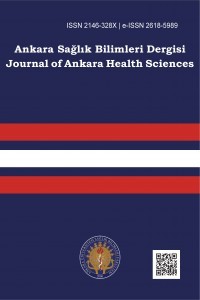Anne Sütünün Gastrointestinal Sistem ve Mikrobiyal Çeşitliliğe Etkisi
anne sütü, probiyotik, anne sütü mikrobiyotası
The Effect of Breast Milk on the Gastrointestinal System and Microbial Diversity
Breast milk, probiotic, Breast milk microbiota,
___
- 1. Ahern, GJ., Hennessy, A., Ryan, CA., et al. 2019. Advances in infant formula science. Annu. Rev. Food Sci. Technol ;10:75–102.
- 2. Albesharat, R., Ehrmann, MA., Korakli, M., et al. 2011. Phenotypic and genotypic analyses of lactic acid bacteria in local fermented food, breast milk and faeces of mothers and their babies. Syst. Appl. Microbiol ;34(2):148-155.
- 3. Alp, G. 2008. Bifidobacterium Cinsi Bakterilerin Bazı Probiyotik Özelliklerinin Belirlenmesi. Yüksek Lisans Tezi. Gazi Üniversitesi Fen Bilimleri Enstitüsü, Ankara.
- 4. Alp, H., Altınkaynak, S., Yıldız, L. 1991.Anne sütünün enfeksiyonlardanm koruyucu etkisi. Aile ve Toplum Yıl; 1:1. 5. Amenyogbe, N., Kollmann, TR., Ben-Othman, R. 2017. Early-Life Host-Microbiome Interphase: The Key Frontier for Immune Development. Front Pediatr ; 5(111): 1-12.
- 6. Arda, DB. 2018. 0-2 Yaş Çocuklarda Anne Sütü İle Beslenme Süresinin Enfeksiyon Sıklığı Üzerine Etkileri. Tıpta Uzmanlık Tezi. İstanbul Üniversitesi Cerrahpaşa Tıp Fakültesi Çocuk Sağlığı ve Hastalıkları Anabilimdalı, İstanbul.
- 7. Arici, M., Bilgin, B., Sagdic, O., et al. 2004. Some characteristics of Lactobacillus isolates from infant faeces, Food Microbiol ;21(1):19-24.
- 8. Arumugam, M., Raes, J., Pelletier, E., et al. 2011. Enterotypes of the human gut microbiome. Nature ;473:174–180. 9. Bakker‐Zierikzee, AM., Van Tol, VAF., Kroes, H., et al. 2006. Faecal SIgA secretion in infants fed on pre‐ or probiotic infant formula, Pediatric Allergy and Immunolgy ;17(2):134-140.
- 10. Balmer, SE., Wharton, BA. 1989. Diet and faecal flora in the newborn: breast milk and infant formula. Arch Dis Child ;64(12):1672-1677.
- 11. Bezirtzoglou, E., Tsiotsias, A., Welling, G W. 2011. Microbiota profile in feces of breast- and formula-fed newborns by using fluorescence in situ hybridization (FISH). Anaerobe ;17(6):78-482.
- 12. Bode, L. 2012. Human milk oligosaccharides: every baby needs a sugar mama. Glycobiology ;22(9):1147–62. 13. Caicedo, RA., Schanler, RJ., Li, N, et al. 2005. The developing intestinal ecosystem: implications for the neonate. Pediatr Resource ;58(4):625-8.
- 14. Cani, PD., De Vos, WM. 2017. Next-generation beneficial microbes: the case of Akkermansia muciniphila. Front. Microbiol ;8:1765.
- 15. Cherbur, C. 2002. Inulin and oligofructose in the dietary fiber concept. Brit J Nutr ;87:159–162.
- ISSN: 2146-328X
- Yayın Aralığı: Yılda 2 Sayı
- Başlangıç: 2012
- Yayıncı: Ankara Üniversitesi
COVID-19 Pandemisi ve Kırılgan Yaşlılarda Hemşirelik Yaklaşımları
Hemşirelik Öğrencilerinin Bireyselleştirilmiş Bakım Algıları İle Merhamet Düzeyi Arasındaki İlişki
Sevgi PAKİŞ ÇETİN, Kıvan ÇEVİK
Sevil PAMUK CEBECİ, Hilal KARA
Çocukların ve Ebeveynlerin Sağlık Eğitimi Bakış Açılarının Karşılaştırılması
Tip 2 Diyabet Modeli Ratların Karaciğer Dokularında Kodlanan Genlerin İfade Düzeyleri
Lütfiye ÖZPAK, Ayfer PAZARBAŞI
Anne Sütünün Gastrointestinal Sistem ve Mikrobiyal Çeşitliliğe Etkisi
Tuğçe MUSLU ATA, Esin KIRAY, Ergin KARİPTAŞ
Gebelik Döneminde Kanıta Dayalı Yaklaşımların Güncel Rehberler Doğrultusunda İncelenmesi
Duygu SEZGİN, Yasemin AYDIN KARTAL
Diyet Memnuniyet Ölçeğinin Türkçe Formunun Geçerlik ve Güvenirlik Çalışması
